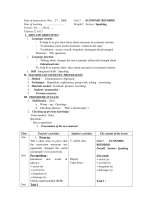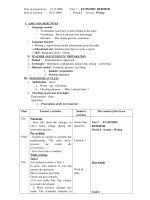Teaching plan 12
Bạn đang xem bản rút gọn của tài liệu. Xem và tải ngay bản đầy đủ của tài liệu tại đây (96.44 KB, 8 trang )
Theme: Education Unit 4: School education
system
P. Syllabus: 21 Period 1 - Reading - Time: 45 minutes.
Preparing date:……/……./ 200….
Teaching date:……/……./ 200….
A. Aims: By the end of the lesson Ss will be able to:
- understand more about School education system in England.
- use vocabulary related to the topic of the lesson through exercise.
B. Teaching aids: Pictures, poster, handouts and real objects
C. Teaching method: Communicative approach
D. Procedure:
1. Class organization:
2. Checking the old lesson:
3. New lesson:
TEACHER’S ACTIVITIES STUDENTS’ ACTIVITIES
A. Warm up:
- Writes down on the board and step by step gives
question:
O
- What is this?
OO
- What can you see now?
- And now?
-- -- -- OO -- -- -- --
- An uncompleted word with four missing letters.
- Now make a meaningful word by filling the blanks with
suitable letters.
- Introduce the new lesson :
School education in England
.
B. New lesson:
I. Pre reading:
- Asks Ss to look at the picture, work in pairs and describe
the situation in the picture. Give the name of School
education in England.
- Asks Ss to read the Fact about school in pairs.
- Asks Ss to guess the content of the passage.
Keys:
1 2 3 4 5
T F T F T
- Is it the same or different in England?
II. While reading:
1. Task one:
- Reads the sentences in the Facts about schools -page
44.
- Asks Ss to read the passage quickly and try to
understand the content of the passage as much as
Answer teacher's question.
- A circle/ The letter O!
- Two eyes/ a pair of glasses/ Two letter O.
- Whole class.
- Answer: SCHOOL.
- Suggested words:
- Primary school, lower secondary school, upper
secondary school.
- Pair work.
1. Answers -Task one:
1. state school
2. primary school
3. secondary school
4. compulsory
possible.
- Asks Ss to guess the meaning of the new words.
- Guides students how to practise.
- Asks students to work in pairs.
- Walks around and help them.
- Calls students to say.
- Corrects their mistakes.
2. Task two:
- Guides students how to practise.
- Asks students to read the passage carefully to answer
the questions.
- Helps the students with new structures.
- Walks around and help them.
- Calls some student to stand up and report before the
class.
- Corrects their mistakes.
- Hand out:
After you read
- Asks Ss to work in groups of 4. Each student say about
one subject which they feel difficult and wishes what the
teacher can help his or her to study better.
5. the GCSE (General Certificate of Secondary
Education)
6. curriculum
7. the GCE level
2. Answers -Task two:
1. From the age of 5.
2. 3 terms
3. the state school and the independent school or public
school.
4. Yes
5. There are 3 core subjects ( English, Maths and
Science)
6. They have to take an exam called GCSE.
- Answers: ( Hand out)
1. Academic
2. Autumn
3. Spring
4. Summer
5. state
6. public
7. primary
8. secondary
- Whole class.
After you read
- Each student say about one subject which they feel
difficult and wishes what the teacher can help his or her to
study better.
- Individual work.
4. Summary: Demand students to master: 1. The main topics in the section.
2. The structures to say.
5. Homework: - More practice the main topics at home.
- Prepare the section C (The Listening part of Unit 4).
E. Comments:
Theme: Education Unit 4: School education
system
England Schooling
__(1)__ year
__(2)__ term
__(3)__ term __(4)__ term
__(5)_school 93%
of the pupils
__(6)_school
fee paying
__(7)__ school
__(8)__ school
GCSE
P. Syllabus: 22 Period 2 - Speaking - Time: 45 minutes.
Preparing date:……/……./ 200….
Teaching date:……/……./ 200….
A. Aims: By the end of the lesson, students will be able to:
- Understand more about the school systems in Viet Nam.
- Develop speaking skills: discuss about the similarities and differences between the school system
in Vietnam and in England.
B. Methods : Communicative approach
C. Teaching aids: Pictures, poster, handouts and real objects
D. Procedures:
1. Class organization:
2. Checking the old lesson:
3. New lesson:
TEACHER’S ACTIVITIES STUDENTS’ ACTIVITIES
A. Warm up:
- Writes on board a series of schools then asks Ss to
rearrange them in order.
- These are the names of levels of education . Put them in
the right order from low to high level.
+ university, nursery, primary school, college,
kindergarten, secondary school.
- Checks in front of class.
B. New lesson:
- Asks Ss to open the textbook on page 45 and do Task 1
- Asks students about ways of communication..
1. Task one:
- Gives the requirement:
Study the table on page 45 and practise asking and
answering questions about the school education system
in Vietnam.
- Asks students to read the information in the table.
- Helps Ss to pronounce and meaning of the new words.
- Walks around and help them.
- Calls students to say.
- Corrects their mistakes.
- Asks Ss to practise.
2. Task two:
- Guides students how to practise.
- Asks students to work in pairs.
- Helps the students with new structures.
- Walks around and help them.
- Calls some student to stand up and report before the
class.
- Corrects their mistakes.
3. Task three:
- Work in group and talk about the school education
system in Vietnam, using the information from Task 1.
Answer teacher's question.
- Put the name of levels of education in the right order
from low to high level.
- Group work
- Answer:
Nursery -> kindergarten -> primary school ->
secondary school -> college -> university.
1. Task one:
- Pair work.
- Practice depend on the information in the table.
* Useful expression:
- When do children in Vietnam go to?
- How old are children when they first go to school?
- How long is the primary school?/ How many years do
children attend primary school?
- Which level do children move to after they finish?
- Pair work.
2. Task two:
Ex:
A. In Viet Nam, children can go to Nursery school when
they are 1 to 2 and go to Kindergarten when they from 2
to 5.
B. I am sure they cry a lot because they are too young to
be far from their parents for the whole day.
A. ....Children leave high school at the age of 17.
3. Task three:
- There are some differences between the school systems
- Guides students how to practise.
- Asks students to work in pairs
- Calls some pairs of student to stand up and practise.
- Corrects their mistakes.
+ compulsory [kəm'pʌlsəri] (a)bắt buộc
in Vietnam and in England. Children in Vietnam start
primary school at the age of 6 and finish this level at 10
while those in England study at primary school from the
age of 5 to 10. Schooling is compulsory for Vietnamese
children until the age of 14, but in England, compulsory
education ends when children are 16. There is also a
difference about the subjects studied at school.
+ Viet Nam:
…………………………………………
+ England:
………………………..………………
4. Summary: Demand students to master: 1. The main topics in the section.
2. The structures to say.
5. Homework: - More practice the main topics at home.
- Exercise C page 32 in the Ss' workbook.
- Prepare the section C (The Listening part of Unit 4).
E. Comments:
Theme: Education Unit 4: School education
system
P. Syllabus: 23 Period 3 - Listening - Time: 45 minutes.
Preparing date:……/……./ 200….
Teaching date:……/……./ 200….
A. Aims: By the end of the lesson, students will be able to:
- Listening, mastering the content of the tape between Jenny and Gavin about their study at school.
- Doing the tasks fluently (Deciding true or false statements, Comprehension questions).
- Develop listening skills: listening for main ideas and specific information
B. Methods : Communicative approach
C. Teaching aids: cassette, pictures, textbook, workbook, cards…
D. Procedure:
1. Class organization:
2. Checking the old lesson:
3. New lesson:
TEACHER’S ACTIVITIES STUDENTS’ ACTIVITIES
A. Warm up:
- Asks Ss to write down five things that you do in your
school days.
- Asks Ss to work in group and answer in front of class.
B. New lesson
Before you listen:
- Group works:
- Answers:
Doing exercises/ Learning lessons/ Playing sports/ taking
tests/ Listening to teachers/ making friends/ wearing
uniform/ Writing lessons/ reading books/ doing research/
Behaving well with friends/ surfing internet...
- Asks students to look at the pictures and talk:
+ What school subjects are you good at?
+ Which one do you enjoy most ?
- Asks students to talk.
- Corrects their mistakes.
Listen and repeat
- Reads and ask students to listen
- Lets students listen again and to repeat.
- Writes some words on board and ask students to read
them aloud.
- Corrects.
While you listen:
1. Task one:
- Asks students to read the questions quickly.
- Guides students the requests of the task.
- Lets students listen twice time.
- Writes on board from 1 to 6 and call some students to
come and write their answers.
- Lets them listen on again and correct.
- Corrects.
2. Task two:
- Asks students to read the question quickly.
- Guides students the how to do the task.
- Lets student listen one or twice times.
- Asks students to stand up and speak their answers.
- Corrects.
After you listen
- Talk with a partner about your study.
Before you listen:
- Look at the pictures.
- Answer the teacher's questions.
+ They are ………
+ They are ………….
Listen and repeat:
Tear away, methodical, disruptive
- Listen and repeat.
- Practise in pairs.
While you listen:
1. Task one:
- Read the questions quickly.
- Listen to .
Answer:
1. Jenny/ Gavin
2. Gavin
3. Jenny
4.
5. Janny. Gavin
6.
2. Task two:
Listen them answer.
1. They enjoy he subjects.
2. he found it verry difficultly
3. Because they were difficult for him to do in a short time.
4. Because he went away for boarding school when he was
quite young and he didi't like that. So school weren't the
best days of his life.
After you listen:
Practise.
4. Summary: Demand students to master: 1. The main toppics in the section.
2. The structures to say.
5. Homework: - More practice the main toppics at home.
- Prepare the section C (The Writing part of Unit 4).
E. Comments:
Theme: Education Unit 4: School education
system
P. Syllabus: 24 Period 4 - Writing - Time: 45 minutes.









